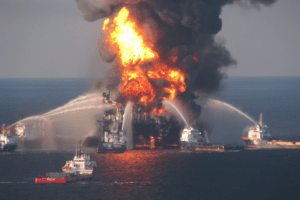Of all the hazards that worry shipowners, masters, seamen and passengers, shipboard fires are the ultimate nightmare. Ships, no matter what function they perform or what size they are, are vulnerable to fire because they are full of combustible materials. Tragically, fires at sea have killed or injured thousands of ships’ crews and passengers. Many of these disasters may have been avoided, but often they are caused by unseaworthiness issues, poor training of crews, and negligence on the part of owners, captains, and/or ships personnel.

Prominent Shipboard Fires
1934 SS Morro Castle
On September 8, 1934, just hours after her captain died of a heart attack, the passenger ship SS Morro Castle caught fire off the coast of New Jersey while sailing from Havana to New York City. The fire could have been contained if the crew had used fire extinguishers immediately. However, there was a delay when the seamen who noticed the fire in the ship’s Writing Room went to the bridge to report it to the acting captain. This delay, as well as the failure to close the ship’s fire-and-smoke doors, allowed the fire to spread to other compartments. The SS Morro Castle burned, and 135 of the 549 passengers and crew aboard were killed.
1984 Scandinavian Sun
On August 20, 1984, the Scandinavian Sun, then operated by SeaEscape, was docked at the Port of Miami after returning from a one-day cruise to Freeport in the Bahamas. A fire broke out in the ship’s generator room and spread into the engine room. Although the smoke/fire detectors worked, the pilothouse was unmanned at the time and the fire alarm was not heard in time. As a result, no one had closed the ship’s fire doors or shut down the ventilation system. Smoke vented up into the rest of the ship, including the lobby area where passengers were getting ready to disembark. The captain closed the ship’s fire doors and the ventilation when he reached the bridge, but one passenger and one crewmember were killed, 31 persons were injured, and 58 were treated for smoke inhalation.
2007 MV Dona Paz
The Philippine passenger ferry MV Dona Paz collided with the tanker Vector while it was sailing from Catbalogan to Manila. The Vector was carrying 8,800 tons of petroleum when it hit the Dona Paz. The Vector’s cargo caught fire, which then spread to the Dona Paz. The entire 58-member crew of the passenger ferry was killed, and the ferry sank with an unconfirmed number of persons aboard. The official death toll, based on the Dona Paz’s manifest, is 1565, but unofficial estimates put the actual count at more than 4,000. According to the official accident investigation, the Victor’s crew was not properly qualified and the ship was operating with an expired license.
2013 Grandeur of the Seas
On May 27, 2013, the Royal Caribbean cruise ship Grandeur of the Seas was damaged by a fierce blaze which raged for three hours until it was extinguished. The ship, which was carrying 3,000 passengers and crew members, was en route to Coco Cay in the Bahamas when a fire broke out on one of the aft mooring decks around one in the morning. According to testimony at a Congressional hearing on cruise ship safety, the fire was not extinguished easily because the mooring deck was not close to a deluge system vale, which would have doused the flames if it had been more accessible. In addition, the fire spread because one of the deck hatches had been left open. There were no deaths or serious injuries reported, but the Coast Guard said it needed to inspect the entire Vision-class of cruise ships, which includes the Grandeur of the Seas and five sister vessels.
2013 Carnival Triumph
The Carnival cruise ship Triumph experienced two onboard fires within two months in 2013. The first took place in February 10, when an engine room fire cut all power to the ship and left her adrift in the Gulf of Mexico until it was towed back to Mobile, Alabama four days later. No one was injured, but conditions aboard the stranded cruise ship were so bad that some passengers later filed suits claiming that the Triumph was unseaworthy.
On April 24, 2013, the Triumph, with 800 crew members aboard, had to be evacuated when two fuel barges exploded in the ship channel near Mobile’s George C. Wallace Tunnel. Three seamen on the barges were burned as a result of the explosion. The barges were being cleaned when a fuel-oil return line connected to a generator leaked, causing an explosion.
Lawsuits filed by several passengers state that the company knew that there was a chance that fuel lines in the Triumph were likely to leak but did not do anything to remedy the issue. The lawsuits charge Carnival was negligent in its failure to prevent the February fire which resulted in the Triumph’s “poop cruise” stranding.
Shipboard Fires and the Jones Act
Seamen and passengers who are injured by a fire aboard a ship are covered by the compensation provided by the Jones Act and maritime law. The Jones Act gives victims of shipboard fires the right to file lawsuits against shipowners, employers, masters, and members of a ship’s crew if their injuries were the result of negligence or unseaworthiness. Jones Act compensation provides compensation, including maintenance and cure payments, lost wages, and present and future medical expenses.
Sources:
- http://www.cnn.com/2014/02/25/travel/carnival-triumph-cruise-trial/
- http://www.maritime-executive.com/article/shipboard-fire-fighting-challenging-worst-case-scenario-mitags/
- http://www.cruiseshipfires.com/Fires/Vina_Express_1_Fire_January_20_2014.html
- http://www.nbcnews.com/business/travel/really-primitive-stuff-safely-ashore-cruise-passengers-tell-hoarding-filth-f1B8325828
- http://www.royalcaribbeanblog.com/category/category/grandeur-seas
- http://www.usatoday.com/story/travel/news/2013/12/19/carnival-cruise-fire-lawsuit/4122947/